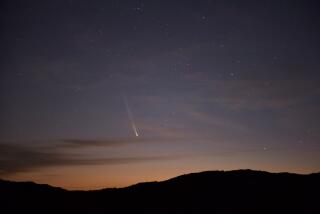Makes Closest Approach to Earth : Celestial Curtain Falling on Halley’s Comet Drama
- Share via
CERRA TOLOLO OBSERVATORY, Chile — Growing dimmer with each passing day, Halley’s comet made its closest approach to Earth on Thursday at 1:44 p.m. (Pacific Time) and then continued its cold, solitary journey through the solar system.
It will not come this way again for 75 years.
Many astronomers made the pilgrimage up the long, dusty road to this Andean outpost to take a front row seat for the passing.
But even to the naked eye, Halley glistened in the crisp evening sky--a faint patch of fuzz some 39 million miles away. The comet contrasted with a sky so clear that stars much too faint to be seen elsewhere stood out like jewels in a universe too beautiful to be flawed.
Halley’s tail is growing shorter and its nucleus dimmer as it wraps itself in a crust of dirt and ice for its coming winter.
The official record will show that the comet’s closest approach to Earth came today in the universal time that is used by all astronomers. But that translates into Thursday for much of the world.
As the comet passed, hundreds of astronomers around the globe trained their telescopes on the dirty little snowball in a uniquely coordinated effort that may be Halley’s legacy during this visit. The effort, involving astronomers from 47 countries under a loosely organized umbrella called the International Halley Watch, was without precedent in the world of science.
“It’s been phenomenal,” said Susan Wyckoff, an Arizona State University astronomer who is believed to have logged far more hours watching Halley than any other astronomer in the world.
Tonight, she will be the envy of cometologists everywhere because she will be in command of the four-meter, premier telescope in the Southern Hemisphere that is also one of the most important U.S. scientific complexes anywhere. Most astronomers would stop just short of murder for a few hours on the giant scope. Wyckoff has had it for 30 entire nights.
‘Revolutionized Our Ideas’
Halley has “revolutionized our ideas about comets,” she said in an interview here.
But it also has changed the course of science, Wyckoff and others believe.
“It has been very different for science,” she said. “It has been a sociological experiment. We’re talking on the telephone or by telex or by radio with other astronomers everywhere.”
“Halley has been the most important event in the history of the astronomical world,” added Hugo Moreno of Chile, one of astronomy’s elder statesmen.
“So many people around the world are involved with no political division,” said Moreno, who picked this pristine peak in the coastal mountains at the foot of the Andes for the observatory that is run by the United States. “That’s important for science.”
That view is also shared by Freeman Miller of the University of Michigan, whose craggy old face is showing the strain of spending the past 31 nights here photographing Halley’s tail through a telescope.
Miller and a colleague have collected more than 200 photographic plates showing how the comet’s ionized tail interacts with solar wind, which may tell more about the sun than the comet.
‘Available to Anyone’
“The plates will be deposited at Goddard (Space Flight Center in Greenbelt, Md.) to be available to anyone,” he said.
What makes the work of scientists like Miller extraordinary is the fact that other astronomers around the world are doing the same thing at the same time in order to capture the comet continuously. All of their work will be available to astronomers at Goddard.
Their instruments are detecting the chemical composition of the comet, and they are seeking to determine such things as the rotation of the nucleus, believed to be once every two days.
Ultimately, Moreno said, “it will be possible to construct a model of the comet so you can speculate on what is going on.”
Such information is important because comets are believed to constitute the most unspoiled remnants of the formation of the solar system. “A comet is a witness of the past,” he said.
But even at this late date, Halley is still playing a few tricks. Astronomers had thought that now would be its closest approach to Earth--and thus the best time to view the comet.
It turns out that they were wrong.
“Last month, it was much better,” Moreno said.
‘Impossible to Predict’
“It as impossible to predict,” he said, obviously relishing the fact that Halley can still be a bit slippery.
Most of the scientific results so far confirm what astronomers already have deduced during the past few years, which comprise perhaps the most concentrated period of study ever of a single celestial object.
That global effort also included five spacecraft--two from the Soviet Union, two from Japan and one from Europe--that encountered the comet last month. Together, the effort is yielding mountains of data that will take years to understand.
Most of the astronomers who have been involved will meet in Heidelberg, Germany, to compare results next October, by which time Halley will be beyond the range of all but the most powerful telescopes.
Tourists Come for a View
But even as the comet is changing so rapidly by the day, it is still an enchanting sight. And hundreds of tourists, including many Americans, are journeying to this area to view the comet.
Each night, dozens of tour buses lumber into the hills from the nearby resort community of La Serena, loaded with tourists who will spend the evening in the hills, gazing at the distant wonder.
If the view is a disappointment to any of them, it doesn’t show on their faces.
“There’s only one Halley’s comet,” Wyckoff said. “It’s unique. Something compels people to want to see it.”
More to Read
Sign up for Essential California
The most important California stories and recommendations in your inbox every morning.
You may occasionally receive promotional content from the Los Angeles Times.













